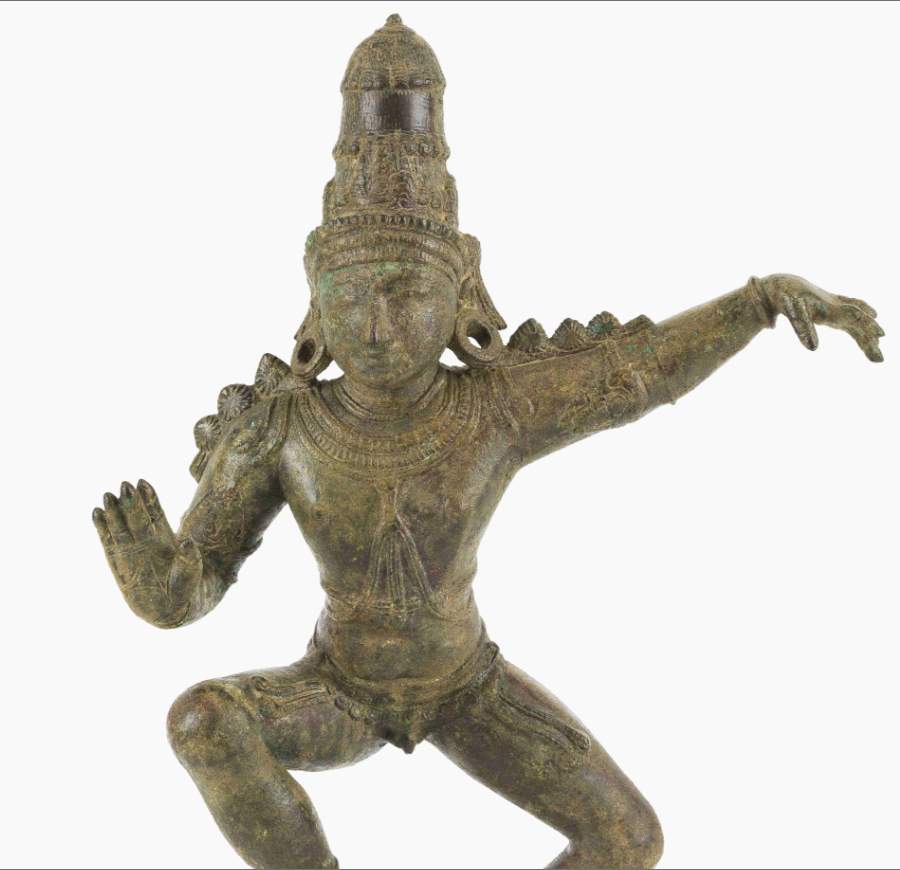The figure of Krishna
The Folch collection has a fine selection of sculptures representing Hindu deities. We will focus on one of them, Krishna, to try and approach the complexity of these beliefs, which have the third-largest number of followers in the world.
This figure, dated somewhere between the 12th and 14th centuries, represents Bala Krishna, or Child Krishna, which is simultaneously a representation of the god Vishnu. It comes from the lands of the Tamils, in south-eastern India.
In this period and region, some very similar figures were sculpted. However, they do not represent a god, but rather a saint, the poet Sambandar, a devotee of a different god, Shiva.
Both of them represent a child, but the figure of the saint evokes a legend that can give us some clues.
The child Sambandar was in the temple of Shiva, and there, Parvati, the god's wife, offered him a cup of milk. When Sambandar's father saw milk on his son's mouth, he asked who had given it to him. The saint pointed towards heaven and started to dance and sing a song praising the god Shiva.
So, the way of telling if the sculpture represents Sambandar or Krishna is to look at the figure's right hand: if it is pointing towards heaven, it is an image of the saint. The gesture made by Krishna in this figure, with an open hand, is a sign of protection, although there are other representations where the figure is holding a ball of butter, in reference to his fondness for stealing butter from local houses. It is possible that the confusion surrounding these two figures is caused by the similarity of the two legends.
In spite of the position of their hands, the two figures have a lot in common, including their posture and the headdress, earrings and necklaces they both wear.
There are many photographs online that are erroneously attributed, and auction houses conscientiously point out the details that confirm the correct identification of the figures they are selling.
Apart from the confusion between god and saint, it is important to note that Shiva and Vishnu are two of the main Hindu deities and there are different movements that claim one or the other as the supreme or most important god. For example, the Chola dynasty, which ruled over the Tamil lands in the period when these figures were made, is considered to be Shaivites, i.e. followers of Shiva.
For Europeans, with a culture dominated by Christian monotheism for nearly two millennia, it is difficult to understand the polytheism practised in India, where the existence of various gods, with different local names and cults, can coexist with more abstract ideas about the existence of a single primordial god creator —or two, or three— and a series of moral codes and rituals that are even shared by other religions, such as Buddhism, Jainism and Sikhism.
Scholars explain that the multiple incarnations and representations of Indian deities is due to various processes of political and cultural expansion, which meant that small gods that were worshipped locally were assimilated into gods that were considered to be superior. After all, this is not too different from the Romans founding temples where the colonised peoples worshipped their own gods, or the stories of Christian saints that are inspired by pagan legends.
Indeed, the life of Jesus is surprisingly similar to that of other Egyptian, Middle Eastern and Indian gods and prophets, such as Krishna himself.
Related pieces
You may also be interested in...
Crosses of Ethiopia
Dr. Ewa Balicka-Witakowska, PhD
The small pendant crosses are worn by every Ethiopian Christian but especially by women, often as a complement to a cross-tattoo on the forehead, hand or neck.
Further informationIfa divination
Hall no. 5 in the Montcada Venue, on the ground floor, is dedicated to the Yoruba culture. One of the main characteristics of their beliefs is the art of Ifa divination.
Further informationNature in Japanese art
Dr. Ricard Bru
Both the ancient ethnic religion – Shinto – and the poetry anthologies dating from the 8th century show how the Japanese people’s profound empathy towards nature has become one of the main idiosyncratic traits of their culture.
Further information





